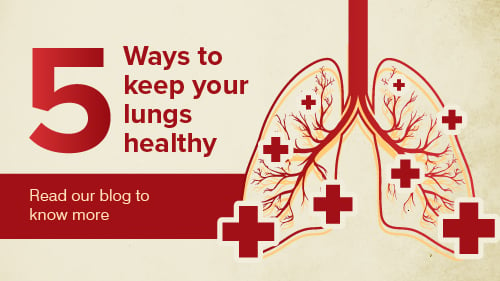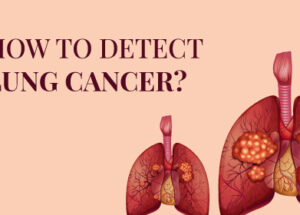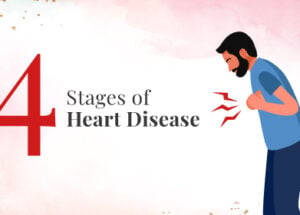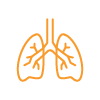All About Lungs Function
February 10, 2025

The lungs serve as the essential organs that enable breathing. Every cell in the body needs oxygen to stay alive and healthy. Your body needs to eliminate carbon dioxide. This gas is a by-product of the cell’s normal functions. Your lungs are designed to exchange air in and out every time you breathe. The primary function of the lungs is to help oxygen from the air we breathe enter the red cells in our blood.
Structure of Lungs
The lungs are positioned within the rib cage, flanking the heart on both sides. The lungs have a conical shape, featuring a rounded apex and a flat base that rests on the diaphragm.
Although they are paired, the lungs are not uniform in size and shape. The left lung features a cardiac notch, an indentation on its side near the heart. The right lung is slightly shorter to accommodate the liver beneath it. The left lung generally has less weight and capacity than the right.
The lungs are surrounded by two membranes called the pulmonary pleura. The inner layer covers the lungs’ outer surface, while the outer layer adheres to the rib cage’s inner wall. The space between these membranes is filled with pleural fluid, which keeps them moist and minimizes friction during breathing.
What is the Respiratory System
The respiratory system consists of various organs and tissues that work together to enable breathing. The airways, lungs, and blood vessels are part of the respiratory system. Your muscles are also part of the body’s respiratory system.
What are the 7 Functions of the Lungs
Besides helping us breathe in and out, it has many other functions.
- Gas exchange – Oxygen enters the blood while carbon dioxide is expelled during the exchange process.
- Breathing – Enables inhalation and exhalation.
- Speech – Provides airflow for speaking.
- Smell – Moves air past the olfactory nerve for scent detection.
- Protection – Filters out harmful particles and irritants.
- Temperature regulation – Warms and humidifies inhaled air.
- Clearing mucus – Helps remove mucus from the body.
Anatomy: Parts of the Respiratory System
The respiratory system has many different parts that help you breathe. Your airways allow air to enter your lungs, and it is a complicated system that includes
- The mouth and nose are openings on your body that let air from the outside world into your respiratory system.
- Sinuses are hollow areas between the bones in your head that help keep the oxygen you breathe warm and humid.
- The pharynx serves as a conduit for air, moving it from the nose and mouth to the trachea.
- The trachea is a tube that connects your throat and lungs.
- The bronchial tubes connect your windpipe to each of your lungs.
- Lungs are two organs that extract oxygen from the air and pass it into the blood.
Your lungs supply oxygen to your organs and body tissues. Muscles and bones help move air into and out of your lungs. The respiratory system’s muscles and bones comprise the following:
- Diaphragm: The muscle responsible for enabling the lungs to inhale and exhale air.
- Ribs are bones that surround and protect your lungs and heart.
When you breathe, your blood carries carbon dioxide and other waste out of the body. Other components that work in the lungs and blood vessels are:
- Inside the lungs, alveoli are small air sacs that facilitate the transfer of oxygen into the bloodstream while removing carbon dioxide.
- Alveoli walls contain blood vessels called capillaries that transport carbon dioxide and oxygen.
- Bronchioles are small branches of the bronchi that lead to the alveoli.
- Lung lobes: The lungs are divided into sections, with the right lung having three lobes and the left lung having two lobes.
- Pleura: Thin sacs surrounding each lung lobe and separating the lungs from the chest wall.
The other parts of your respiratory system include
- Cilia move in a wave-like motion to filter out dust and other irritants from your airways.
- A small flap of tissue called the epiglottis sits at the trachea’s entrance and seals it off while swallowing to stop food and liquids from going into the airway.
- The larynx is an organ in the neck that allows you to speak and make sounds when air moves in and out.
Conditions that Affect the Respiratory System
Many things can affect the organs and tissues that comprise the respiratory system. For example, some diseases develop because you breathe in irritants such as viruses or bacteria that can cause infection. Others can occur as a result of illness or getting older.
- Allergies: Breathing in proteins like dust, mold, and pollen may trigger respiratory allergies in certain individuals. Such proteins have the potential to trigger airway inflammation.
- Asthma, for instance, is a chronic condition that leads to airway inflammation, making breathing challenging.
- Respiratory infections can cause pneumonia (an inflammation of the lungs) or bronchitis (an inflammation of the bronchial tubes). It includes the flu (influenza) or a cold.
- Lung cancer and chronic obstructive pulmonary disease (COPD) are respiratory illnesses. These conditions can impair the body’s ability to transport oxygen efficiently and remove waste gases.
- Aging: As we age, the lung capacity decreases.
- Damage: Respiratory system damage can cause breathing problems.
Lung Function Test
Several tests determine how well the lungs function, including lung function tests (also known as pulmonary function tests). Spirometry is the most basic test. This test determines the amount of air the lungs can hold. The test also measures the ability to expel air from the lungs forcefully.
Spirometry is used to check for lung volume-affecting disorders. Additionally, it’s used to check for conditions like COPD or asthma that affect the airways.
Another typical lung function test is lung volume testing. It measures the amount of air in the lungs, including the air still in the lungs after a typical breath, and is more accurate than spirometry.
Five Ways to Keep Your Lungs Healthy
- Avoid pollutants that harm your airways, including secondhand smoke, chemicals, and radon. Wear a mask if you are exposed to fumes, dust, or other contaminants for any reason.
- Don’t smoke cigarettes.
- Maintain a well-balanced diet rich in fruits and vegetables, and ensure adequate hydration by drinking plenty of water.
- Exercise regularly to keep your lungs healthy.
- Prevent infections by washing your hands and getting a flu vaccine every year.
Frequently Asked Questions
1. Can you live with one lung?
In most cases, a single lung is sufficient for breathing, as it can supply enough oxygen and expel carbon dioxide effectively, unless the remaining lung is compromised.











